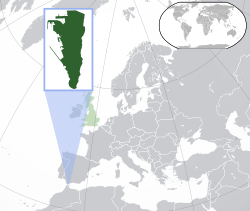Portal:Gibraltar
The Gibraltar Portal Gibraltar (/dʒɪˈbrɔːltər/ ⓘ jih-BRAWL-tər, Spanish: [xiβɾalˈtaɾ]) is a British Overseas Territory and city located at the southern tip of the Iberian Peninsula, on the Bay of Gibraltar, near the exit of the Mediterranean Sea into the Atlantic Ocean (Strait of Gibraltar). It has an area of 6.8 km2 (2.6 sq mi) and is bordered to the north by Spain (Campo de Gibraltar). The landscape is dominated by the Rock of Gibraltar, at the foot of which is a densely populated town area. Gibraltar is home to some 34,003 people, primarily Gibraltarians. Gibraltar was founded as a permanent watchtower by the Almohads in 1160. It switched control between the Nasrids, Castilians and Marinids in the Late Middle Ages, acquiring larger strategic clout upon the destruction of nearby Algeciras c. 1375. It became again part of the Crown of Castile in 1462. In 1704, Anglo-Dutch forces captured Gibraltar from Spain during the War of the Spanish Succession, and it was ceded to Great Britain in perpetuity under the Treaty of Utrecht in 1713. It became an important base for the Royal Navy, particularly during the Napoleonic Wars and World War II, as it controlled the narrow entrance and exit to the Mediterranean Sea, the Strait of Gibraltar, with half the world's seaborne trade passing through it. The sovereignty of Gibraltar is a point of contention in Anglo-Spanish relations as Spain asserts a claim to the territory. Gibraltarians overwhelmingly rejected proposals for Spanish sovereignty in a 1967 referendum, and for shared sovereignty in a 2002 referendum. Nevertheless, Gibraltar maintains close economic and cultural links with Spain, with many Gibraltarians speaking Spanish as well as a local dialect known as Llanito. (Full article...) Selected article - There have been fourteen recorded sieges of Gibraltar. Although the peninsula of Gibraltar is only 6 kilometres (3.7 mi) long and 1 kilometre (0.62 mi) wide, it occupies an extremely strategic location on the southern Iberian coast at the western entrance to the Mediterranean Sea. Its position just across the eponymous Strait from Morocco in North Africa, as well as its natural defensibility, have made it one of the most fought-over places in Europe. Only five of the sieges resulted in a change of rule. Seven were fought between Muslims and Catholics during Muslim rule, four between Spain and Britain from the Anglo-Dutch capture in 1704 to the end of the Great Siege in 1783, two between rival Catholic factions, and one between rival Muslim powers. Four of Gibraltar's changes in rule, including three sieges, took place over a matter of days or hours, whereas several other sieges had durations of months or years and claimed the lives of thousands without resulting in any change in rule. (Full article...) Selected picture Painting credit: John Singleton Copley
The Defeat of the Floating Batteries at Gibraltar, September 1782, an oil-on-canvas painting by Boston-born American artist John Singleton Copley. It depicts the defeat of the floating batteries at Gibraltar during the Great Siege of Gibraltar.
Selected quote
SubcategoriesSelected biography -Admiral of the Fleet Sir John Leake (4 July 1656 – 21 August 1720) was a Royal Navy officer and politician. As a junior officer he saw action at the Battle of Texel during the Third Anglo-Dutch War. He then distinguished himself when he led the convoy that broke the barricading boom at Culmore Fort thereby lifting the siege of Derry during the Williamite War in Ireland. As a captain he saw action in some of the heaviest fighting (70 of his men were killed) at the Battle of Barfleur and was also involved in a successful attack on the French ships at the Battle of La Hogue during the Nine Years' War. Leake went on to be Commander-in-Chief, Newfoundland and then, as a flag officer, served as Second-in-Command to Admiral George Rooke at the Capture of Gibraltar and he commanded the vanguard in the Battle of Málaga during the War of the Spanish Succession. He later returned to Gibraltar with a combined English, Dutch and Portuguese force of 35 ships and defeated Baron de Pointis at the Battle of Cabrita Point. (Full article...) Did you know...
General imagesThe following are images from various Gibraltar-related articles on Wikipedia.
Topics Buildings: The Convent | Dudley Ward Tunnel | Garrison Library | Moorish Castle Communications: .gi | Gibraltar Broadcasting Corporation | Gibraltar Chronicle | Telecom dispute Culture: Cuisine | Gibraltarian people |Gibraltarian status | Languages | Llanito | Music Flora and fauna: Gibraltar Barbary Macaques | Gibraltar candytuft | GONHS | List of birds of Gibraltar | Mammals | List of reptiles and amphibians in Gibraltar | Rock of Gibraltar | The Alameda Gardens History: Battle of Gibraltar | Death on the Rock | Explosion of the RFA Bedenham | George Augustus Eliott, 1st Baron Heathfield | George Rooke | Gibraltar real | Great Siege of Gibraltar | History of the Maltese | History of Nationality | Kingdom of Gibraltar | Military history of Gibraltar during World War II | Moorish Castle | Aurora incident | Pillars of Hercules | Treaty of Utrecht Military: British Forces Gibraltar | Royal Gibraltar Regiment | RAF Gibraltar | HMS Gibraltar | Gibraltar Services Police | Royal Gibraltar Police Symbols: Coat of arms | Flag | Gibraltar Anthem | Other Flags Politics and economy: Chief Minister | Constitution Order (1969, 2006) | Disputed status | Elections | Gibraltar Constitution Order 2006 | Parliament | Gibraltarian pound | Governor | Political parties Religion: Cathedral of St. Mary the Crowned | Cathedral of the Holy Trinity | Great Synagogue | Hinduism | History of the Jews in Gibraltar | Ibrahim-al-Ibrahim Mosque | Methodism | Roman Catholicism | St Andrew's Church Related portalsThings you can doSee alsoAssociated WikimediaThe following Wikimedia Foundation sister projects provide more on this subject:
Discover Wikipedia using portals | ||||||
































































